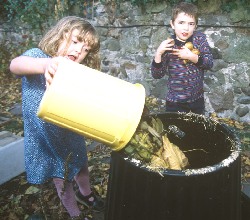
Get the most out of your compost bin
Follow these 5 easy steps to get the most out of your compost bin!
Step 1 - Placing your bin
It is best to place the bin on a level, well drained site.
Putting your bin in a sunny spot will help it work faster, but it is also important to make sure it is easy to get to.
Step 2 - What to put in
Make sure you put in a 50:50 combination of 'green' and 'brown' ingredients.
Greens rot quickly and are a good source of nitrogen, these include:
- fruit and vegetable peelings
- plant prunings
- grass cuttings
Browns rot slowly and let air pockets form in the mixture, these include:
- cardboard
- scrunched up paper
- sawdust
- woody prunings
Step 3 - What not to put in
Do not add the following items as they can cause bad odours and attract pests:
- cooked food
- meat
- fish
- dog and cat faeces
- nappies
Also avoid composting perennial weeds (such as dandelions and thistles) or weeds with seed heads.
Plastics, glass and metals are not suitable for composting and should be recycled separately where possible.
Step 4 - Do as little or as much as you like!
Some people fill their bin and then leave it to compost by itself. This is fine as long as the balance of greens and browns is right, allowing food, air and moisture in your bin.
You can make the composting process quicker by letting more air to enter your bin. The easiest way to do so is to poke holes through your compost with a broom handle.
Step 5 - Using your compost
Finished compost is a dark brown, soil-like layer that you will find at the bottom of your bin after about 9 to 12 months. It has a spongy texture and is high in nutrients.
Find more information on what to do with your compost.
Composting problems solved
If you cannot find the answer here then please call the home composting helpline telephone: 0845 6000 323.
Slimy and smelly bin contents
If the contents of your bin have gone all slimy and smelly you're not putting enough 'browns' into your bin.
These are materials like cardboard and paper, for example, insides of toilet rolls, cereal packets, scrap paper, envelopes (with any plastic windows and gummed edges removed). If you screw these materials up into balls and add them to your bin they'll soak up the moisture and retain the balance of your bin.
If things are very bad think about investing in a bag of wood shavings from a pet shop and mixing it in.
Don't forget to keep adding cardboard, paper and any other 'browns' that you have available.
Rats and mice
Your compost bin should not attract rats and mice as long as you're putting the right things in, or leaving the wrong things out.
Adding meat and fish to your compost bin for example may attract vermin, as will placing the bin in a very secluded place close to a river or stream.
The best way to avoid this from happening is to put your bin in a place where it will be disturbed on a regular basis (as rats and mice are very shy and hate humans).
Add uncooked fruit and vegetable peelings from the kitchen.
Flies in your compost bin
Fruit flies normally live in your compost bin and are not only harmless but are doing an important job. They eat the fruit acids and speed up the composting process.
If you really cannot stand them then there are 2 things you can do:
- leave the lid off the bin for a couple of days - larger insects will come and lay eggs in the bin, the grubs from which will eat the fruit flies and the local bird population will have a free feast
- cover the fruit inside the bin with damp newspaper, kitchen roll or soil to stop the smell getting out and attracting the flies
Compost bin is not filling up
If your bin has not filled up and you've been putting materials into it for a long time, then things are actually working as they should be.
Check your bin to see if you have compost at the bottom. It should be dark brown, be damp but not wet and look very similar to soil with no obvious bits in it.